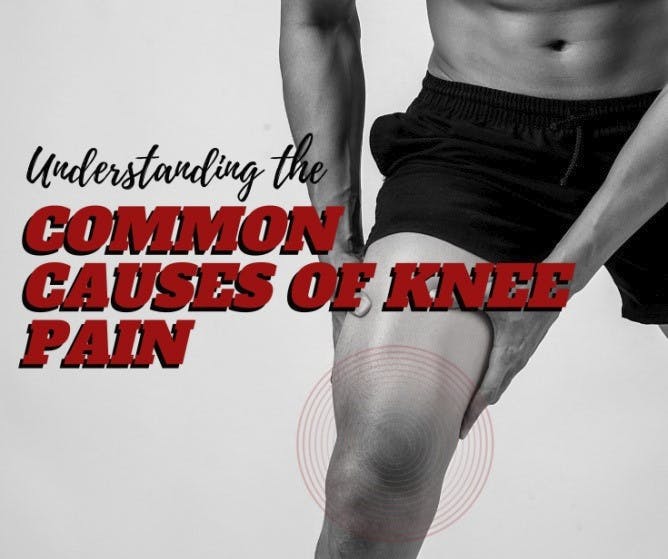Understanding the Common Causes of Knee Pain

Most people, both the young and the old, have experienced knee pain at one point in their lives, either from a sudden injury, overuse, or as a consequence of aging. If you’re an active person engaging in a lot of physical activities or strenuously participating in contact sports, you might probably sustain knee pain from blunt trauma due to direct contact to the knee, from a sudden stop and accustomed movement while avoiding a tackle from an opponent or repetitive overload when running. When you are of advanced age, knee pain may be due to various issues related to aging, mostly from arthritic conditions, gout, and even from infections.
Traumatic Knee Pain
The knee is a complex joint structure surrounded by pain-sensitive soft and bony tissues that are susceptible to injuries from direct contact, a misstep, or a twist. Several bones, cartilages, ligaments, and tendons can be easily compromised with a single slip or wrong move. Knee pain with swelling is the most commonly observed sign of knee injury.
- Fractures: High-impact falls or high-energy blows or collisions may cause fractures. The knee cap, or patella, is the most commonly fractured bone around the knee. Both ends of the thigh bone (femur) and shin bone (tibia), where they meet at the knee, can also be fractured.
- Dislocation: The knee cap can be knocked out from its position by a direct blow to the sides of the knee. Dislocation can also occur with the femur and tibia from high‑energy trauma, such as falls and sports-related contact.
- Ligamentous Injuries: Athletes participating in high-demand sports like soccer, football, and basketball are prone to an anterior cruciate ligament injury, either from a sudden stop and change in direction or from poor landing mechanics during jumps. The posterior cruciate ligament can be injured during motor vehicle accidents from a blow to the front of the knee while the knee is bent. Collateral ligaments are usually caused by a direct blow to either side of the knee.
- Meniscal Injuries: The meniscus is a rubber-like structure situated in the knee between the femur and tibia and acts as a shock absorber. Painful and debilitating meniscal tears can result from forceful twisting or rotating, cutting, or pivoting. It can be due to a sudden stop or rapid stepping.
- Tendon Tears: The patellar tendon can be torn from a direct impact to the front of the knee, such as in high-impact falls and direct blow. Faulty jumping and landing mechanics can also cause patellar tendon tears and rupture.
If knee pain becomes persistent and lasts for more than a week, an individual should consult a doctor or a specialist in Knee Physical Therapy. An urgent appointment with a doctor is also warranted in severe trauma cases during an athletic performance or similar situations.
Non-traumatic Knee Pain
Injury to the knee can be non-traumatic and affects athletes and non-athletes alike. It may be due to overuse or systemic conditions related to advancing age. The following are several common causes of knee pain without injury.
- Bursitis: The small fluid-filled sacs that cushion the knee during movements can be irritated and inflamed often because of old age or repetitive use. The Housemaid’s Knee is the inflammation of the bursa in front of the knee cap that is often seen in people who spends a lot of time kneeling.
- Tendonitis: The patellar tendon below the knee cap can become inflamed with overuse. Athletes who participate in sports that involve a lot of jumping can acquire patellar tendinitis, which is frequently tagged as the Jumper’s Knee.
- Iliotibial Band Syndrome: One of the most common overuse injuries in runners, ITBS, is caused by irritation of the iliotibial band due to friction against the bony prominence on the outer side of the knee, causing lateral knee pain.
- Osteoarthritis: A degenerative joint disease associated with old age that is caused by inflammation and deterioration of the knee joint structures, thus the term Wear-and-Tear arthritis.
- Rheumatoid arthritis: This is a chronic autoimmune disease where the immune system attacks the body’s own tissues and affects multiple joints in the body. It is multisystemic, affecting many organs but mostly the synovial membrane and joints.
Knee pain without any related injury can be difficult to diagnose. It is important to seek advice from an experienced physical therapist to appropriately pinpoint the cause of your knee pain and formulate an appropriate treatment program to address the symptoms.
Many of these causes of knee pains can be prevented and treated. Knee Physical Therapy will always be a great option to get your knees back on track for longer runs and heavier exercises, which are, interestingly, the best ways to combat these painful knee conditions.

